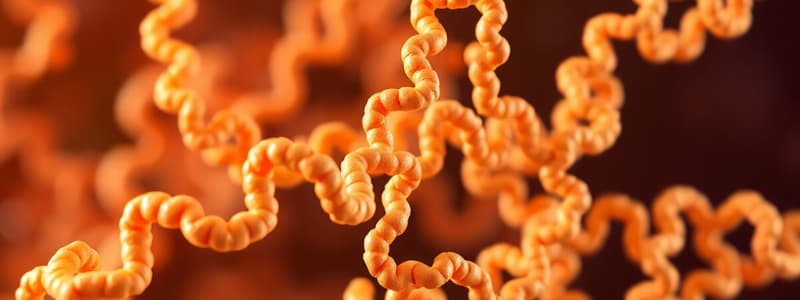Podcast
Questions and Answers
What determines the tertiary structure of a protein?
What determines the tertiary structure of a protein?
- Interactions between the variable side chains (R groups) (correct)
- Interactions between the amino and carboxylic groups
- The sequence of amino acids in the polypeptide chain
- The type of enzyme present in the protein
Which level of protein organization refers to multiple polypeptide chains coming together?
Which level of protein organization refers to multiple polypeptide chains coming together?
- Primary structure
- Tertiary structure
- Quaternary structure (correct)
- Secondary structure
What is the primary structure of a protein?
What is the primary structure of a protein?
- The interaction between different proteins
- The formation of alpha helices
- The 3D shape of the protein
- The sequence of amino acids (correct)
Which function is NOT typically associated with proteins?
Which function is NOT typically associated with proteins?
What type of protein is primarily responsible for immune response?
What type of protein is primarily responsible for immune response?
Flashcards
What is the basic building block of proteins?
What is the basic building block of proteins?
Amino acids are the monomers that make up proteins. Each amino acid has a central carbon atom bonded to an amino group ($NH_2$), a carboxyl group ($COOH$), a hydrogen atom, and a variable side chain (R group) that gives each amino acid its unique properties.
How do amino acids link together?
How do amino acids link together?
Amino acids form peptide bonds, which are covalent bonds that link the carboxyl group of one amino acid to the amino group of another amino acid.
What is primary structure?
What is primary structure?
The primary structure of a protein is its sequence of amino acids. This sequence is determined by the genetic code of the organism.
What is secondary structure?
What is secondary structure?
Signup and view all the flashcards
What is tertiary structure?
What is tertiary structure?
Signup and view all the flashcards
Study Notes
Protein Structure and Function
- Proteins are polymers of amino acids
- Twenty different amino acids with variable side chains (R groups)
- Amino acids linked by peptide bonds to form polypeptide chains
- Primary structure: specific linear sequence of amino acids
- Secondary structure: polypeptide chain folds into spirals (alpha-helices) or sheets (beta-pleated sheets) due to hydrogen bonds
- Tertiary structure: 3D folding of the polypeptide chain due to interactions between R groups
- Quaternary structure: multiple polypeptide chains bind together
- Proteins' functions include: structural support, transport, enzymes, antibodies
Protein Types and Functions
- Some proteins maintain shape (structural proteins)
- Others transport molecules in or out of cells (transport proteins)
- Enzymes speed up chemical reactions
- Antibodies bind to foreign substances like bacteria and target them for destruction
Studying That Suits You
Use AI to generate personalized quizzes and flashcards to suit your learning preferences.




